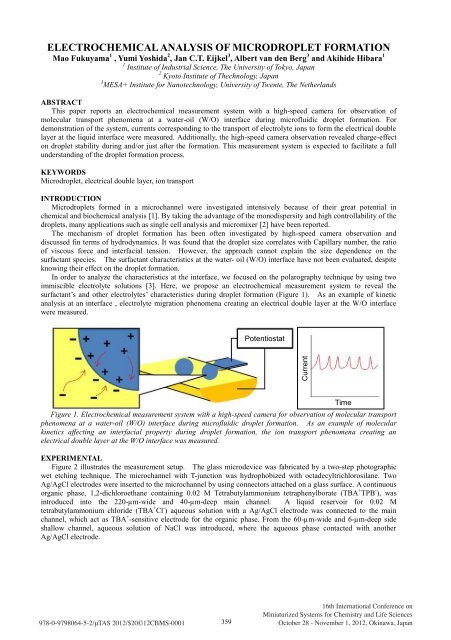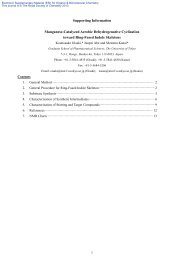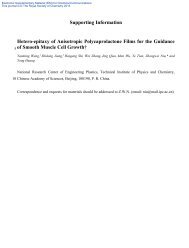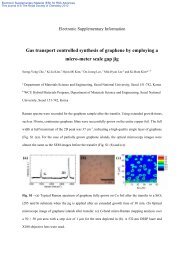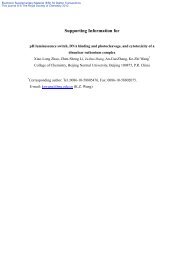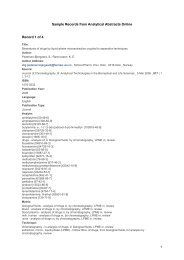electrical double layer
electrical double layer
electrical double layer
You also want an ePaper? Increase the reach of your titles
YUMPU automatically turns print PDFs into web optimized ePapers that Google loves.
ELECTROCHEMICAL ANALYSIS OF MICRODROPLET FORMATION<br />
Mao Fukuyama 1 , Yumi Yoshida 2 , Jan C.T. Eijkel 3 , Albert van den Berg 3 and Akihide Hibara 1<br />
1 Institute of Industrial Science, The University of Tokyo, Japan<br />
2 Kyoto Institute of Thechnology, Japan<br />
3 MESA+ Institute for Nanotechnology, University of Twente, The Netherlands<br />
ABSTRACT<br />
This paper reports an electrochemical measurement system with a high-speed camera for observation of<br />
molecular transport phenomena at a water-oil (W/O) interface during microfluidic droplet formation. For<br />
demonstration of the system, currents corresponding to the transport of electrolyte ions to form the <strong>electrical</strong> <strong>double</strong><br />
<strong>layer</strong> at the liquid interface were measured. Additionally, the high-speed camera observation revealed charge-effect<br />
on droplet stability during and/or just after the formation. This measurement system is expected to facilitate a full<br />
understanding of the droplet formation process.<br />
KEYWORDS<br />
Microdroplet, <strong>electrical</strong> <strong>double</strong> <strong>layer</strong>, ion transport<br />
INTRODUCTION<br />
Microdroplets formed in a microchannel were investigated intensively because of their great potential in<br />
chemical and biochemical analysis [1]. By taking the advantage of the monodispersity and high controllability of the<br />
droplets, many applications such as single cell analysis and micromixer [2] have been reported.<br />
The mechanism of droplet formation has been often investigated by high-speed camera observation and<br />
discussed fin terms of hydrodynamics. It was found that the droplet size correlates with Capillary number, the ratio<br />
of viscous force and interfacial tension. However, the approach cannot explain the size dependence on the<br />
surfactant species. The surfactant characteristics at the water- oil (W/O) interface have not been evaluated, despite<br />
knowing their effect on the droplet formation.<br />
In order to analyze the characteristics at the interface, we focused on the polarography technique by using two<br />
immiscible electrolyte solutions [3]. Here, we propose an electrochemical measurement system to reveal the<br />
surfactant’s and other electrolytes’ characteristics during droplet formation (Figure 1). As an example of kinetic<br />
analysis at an interface , electrolyte migration phenomena creating an <strong>electrical</strong> <strong>double</strong> <strong>layer</strong> at the W/O interface<br />
were measured.<br />
Potentiostat<br />
Current<br />
Figure 1. Electrochemical measurement system with a high-speed camera for observation of molecular transport<br />
phenomena at a water-oil (W/O) interface during microfluidic droplet formation. As an example of molecular<br />
kinetics affecting an interfacial property during droplet formation, the ion transport phenomena creating an<br />
<strong>electrical</strong> <strong>double</strong> <strong>layer</strong> at the W/O interface was measured.<br />
EXPERIMENTAL<br />
Figure 2 illustrates the measurement setup. The glass microdevice was fabricated by a two-step photographic<br />
wet etching technique. The microchannel with T-junction was hydrophobized with octadecyltrichlorosilane. Two<br />
Ag/AgCl electrodes were inserted to the microchannel by using connectors attached on a glass surface. A continuous<br />
organic phase, 1,2-dichloroethane containing 0.02 M Tetrabutylammonium tetraphenylborate (TBA + TPB - ), was<br />
introduced into the 220-µm-wide and 40-µm-deep main channel. A liquid reservoir for 0.02 M<br />
tetrabutylammonium chloride (TBA + Cl - ) aqueous solution with a Ag/AgCl electrode was connected to the main<br />
channel, which act as TBA + -sensitive electrode for the organic phase. From the 60-µm-wide and 6-µm-deep side<br />
shallow channel, aqueous solution of NaCl was introduced, where the aqueous phase contacted with another<br />
Ag/AgCl electrode.<br />
Time<br />
978-0-9798064-5-2/μTAS 2012/$20©12CBMS-0001 359<br />
16th International Conference on<br />
Miniaturized Systems for Chemistry and Life Sciences<br />
October 28 - November 1, 2012, Okinawa, Japan
Ag AgCl<br />
1M<br />
0.02M TBATPB<br />
NaCl aq.<br />
Dichloroethane<br />
0.02M<br />
AgCl Ag<br />
(DCE)<br />
TBACl aq.<br />
WE<br />
Measured<br />
W/O interface<br />
CE/RE<br />
CE<br />
TBACl aq.<br />
TBPTPB<br />
org.<br />
NaCl aq.<br />
TBATPB org..<br />
WE<br />
NaCl aq.<br />
Figure 2. Microdevice for the electrochemical measurement. 1,2-dichloroethane (DCE) solution of<br />
Tetrabutylammonium tetraphenylborate (TBATPB) and NaCl aqueous solution were used as the continuous and<br />
dispersed phases, respectively. Aqueous solution of tetrabutylammonium chloride (TBACl) was used to form<br />
TBA + -ion selective electrode for the organic phase.<br />
RESULTS & DISUSSIONS<br />
The high-speed camera observation shows that the droplet formation process depends on the applied potential<br />
(Figure 3). At a potential of 0.35 V, when a new droplet was generated from the tip of the dispersed phase, the new<br />
droplet repels the previously-generated droplet (Figure 3a). In contrast, when the potential is set to 0.19 V, the<br />
potential of zero charge, the tip of the dispersed phase connects the previously-generated droplet near the junction, or<br />
the new droplet fuses with it immediately, and, then, the volume of the droplet increases (Figure 3b). Because<br />
interfacial tensions under the above two conditions were almost the same, the transient amount of interfacial charge<br />
might be govern the phenomenon. a) 0.40 V.<br />
0.0 ms 0.4 ms 0.8 ms 1.2 ms<br />
b) 0.19 V (PZC).<br />
0.0 ms 0.4 ms 0.8 ms 1.2 ms<br />
500 μm<br />
Figure 3. Micrographs of the droplet formation captured by high-speed camera. (a) The new droplet repels the<br />
previously-generated droplet (0.40V). (b) The tip of the dispersed phase connects and fuses with the<br />
previously-generated droplet near the junction, and the volume of the droplet increases.<br />
Then, the current corresponding to charging of the <strong>electrical</strong> <strong>double</strong> <strong>layer</strong> via electrolyte migration was measured<br />
with a time-resolution of 20 µs (Figure 4). The periodic variation of 800 Hz corresponding to single droplet<br />
formation was observed at all the potentials except 0.19 V. The current increase and drop in the period correspond<br />
to the droplet expansion and its detachment, respectively. The charge of detached droplet at 0.35 V accumulated<br />
during its formation (the time integral of the current) was calculated as 20 pC while that at 0.19 V was negligibly<br />
small. The difference can be considered to represent an <strong>electrical</strong> <strong>double</strong> <strong>layer</strong> around a droplet, which generates a<br />
repulsive force against the other droplet to prevent fusion.<br />
360
Current (nA)<br />
50<br />
40<br />
30<br />
20<br />
10<br />
0<br />
-10<br />
-20<br />
0 2 4 6 8<br />
Time (ms)<br />
0.03V<br />
0.19V<br />
0.40V<br />
0.48V<br />
Figure 4. Results of amperometric measurement. The period of the variation of 800 Hz corresponds to<br />
single droplet formation. The charge at 0.35 V was calculated as 20 pC while that at 0.19 V was<br />
negligibly small. Therefore the difference (Figure 3) can be considered to represent the charge amount at<br />
an <strong>electrical</strong> <strong>double</strong> <strong>layer</strong> around a droplet.<br />
CONCLUSION<br />
Electrochemical measurement system for droplet formation was developed. By using this system, we measured<br />
the amount of charge at the interface of a single droplet as an example of the molecular behavior that affects droplet<br />
stability during its formation. We expected that this system will enable to evaluate the effect of the molecular<br />
kinetics at the interface on the droplet formation process.<br />
ACKNOWLWDGEMENT<br />
We sincerely acknowledge Prof. Noritada Kaji, Prof. Yoshinobu Baba of Nagoya University, Mr. Rerngchai<br />
Arayanarakool and Dr. ir. Séverine le Gac of University of Twente for their kind support. We express gratitude to<br />
Prof. Kohji Maeda of Kyoto Institute of Technology for the helpful discussions, to Prof. Tetsu Tatsuma and Dr.<br />
Nobuyuki Sakai of the University of Tokyo for support regarding the electrochemical measurement and Mr. Toshio<br />
Namekawa of Central Workshop of Institute of Industrial Science, The University of Tokyo for the technical<br />
supports. This work was partially supported by KAKENHI (Grant 24350038), and by the Food Nanotechnology<br />
Project of the Ministry of Agriculture, Forestry and Fisheries of Japan. MF acknowledges the Global COE Program,<br />
Chemistry Innovation through Cooperation of Science and Engineering, MEXT, Japan and the International Training<br />
Program, Program for incubating young researchers on Plasma Nanotechnology Materials and Device Processing,<br />
JSPS for encouragement of research activities.<br />
REFERENCES<br />
[1] H. Song, D. L. Chen and R. F. Ismagilov, Angew. Chem. Int. Ed., 45, pp. 7336–7356 (2006).<br />
[2] M. Fukuyama and A. Hibara, Anal. Sci. 27, pp.671-672 (2011).<br />
[3] S. Kihara, M. Suzuki, K. Maeda, K. Ogura, S. Uetani, M. Matsui and Z. Yoshida, Anal. Chem. 58, pp. 2954-2961<br />
(1986).<br />
CONTACT<br />
Akihide Hibara<br />
+81-3-5452-6341 or hibara@iis.u-tokyo.ac.jp<br />
361


